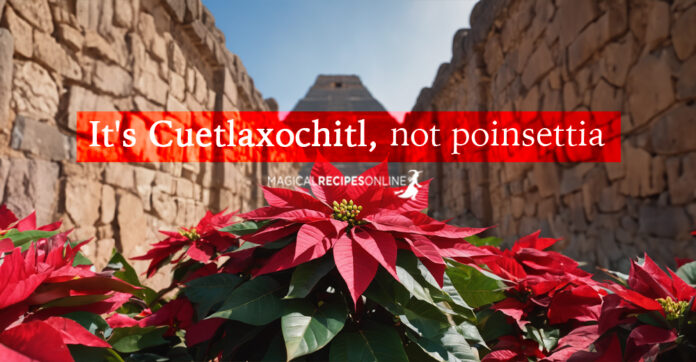You may see this plant everywhere around Christmas time. It’s festive appearance makes it a popular choice for celebrational displays or as a gift during Christmas time. Probably, it’s the most christmasy plant along with mistletoe. But as with mistletoe, it has nothing to do with Christmas. It’s real name is Cuetlaxochitl (kwet-la-sho-she), not poinsettia, a name which comes from the ancient Atzecs an ancient and powerful Mesoamerican civilization. However, Cuetlaxochitl is also known as poinsettia in most parts of the world. Cuetlaxochitl was not just valued its vibrant red and green colors but was also believed it had symbolic and medicinal properties.
Cuetlaxochitl, not poinsettia, a magical Solstice Plant
The plant’s popular designation pays homage to Joel Poinsett, the esteemed American ambassador to Mexico who introduced it to the rest of the World during the mid-1800s. Its botanical nomenclature, Euphorbia pulcherrima, emerges from the Latin language, with the species epithet “pulcherrima” translating to “most exquisite” in English.
One thing is common in ancient and modern use. It played a significant part in Solstice Rituals – probably this is why it is still used in Christmas decoration, as it’s actually a solstice celebration.
But it was not used for decoration. Ancient use of cuetlaxochitl was in religious ceremonies and rituals. The Aztecs considered the plant sacred and believed it represented purity. During festivities and religious events, cuetlaxochitl flowers were used to decorate altars and to honor their deities. The bright red color of the flowers was thought to symbolize blood or sacrifice.
1. Winter Solstice Festival:
Ancient Aztecs celebrated the winter solstice, known as Huitzilopochtli, with a grand festival called the “Panquetzaliztli.” During this festival, cuetlaxochitl flowers were used to decorate the temples and altars dedicated to Huitzilopochtli, the Aztec sun god. It was believed that these vibrant flowers would attract and please the god, ensuring a good harvest and fortune for the upcoming year.
2. Ritual Sacrifices:
Cuetlaxochitl flowers were often used in these ceremonies as symbolic representations of blood and sacrifice as a way to appease their deities and maintain the balance of the cosmos. They were placed on sacrificial altars or offered to the gods along with other offerings.
3. Healing Ceremonies:
The Aztecs attributed medicinal properties to cuetlaxochitl flowers and used them in healing rituals. It was believed that the plant could provide relief from fevers and skin conditions. Shamans or healers would incorporate cuetlaxochitl into their medicinal treatments, either applying it topically or preparing it as a tea.
4. Other practical uses:
Cuetlaxochitl flowers were widely used for their vibrant red and green colors in various festive displays. They were used to decorate temples, homes, and public spaces during special occasions and celebrations, symbolizing joy, abundance, and renewal.
In addition to its decorative purposes, cuetlaxochitl also had practical uses. The Aztecs extracted a red dye from the plant’s bracts, which are the modified leaves that surround the flowers. This dye was used to color textiles, pottery, and even human and animal skin. Cuetlaxochitl was also believed to have medicinal properties, such as treating fevers and skin conditions.
Yule Ritual with Cuetlaxochitl (poinsettia)
To make a wish come true in the new Solar Year. Prepare this Spell in Winter’s Solstice eve (also known an Yule Eve)
Materials needed:
– A poinsettia plant
– A red candle
(both ingredients symbolize the blood of the Goddess – mother Nature and the heat of the Reborn Sun – God)
Instructions (seven steps):
1. Set up a sacred space: Clear a small space in your home where you can perform your ritual. Place a cloth or any items that hold personal significance for you.
2. Prepare the poinsettia: Take a red poinsettia plant or find a red poinsettia bract. If using a plant, find a red bract and gently remove it. Hold the bract between your palms and feel its energy.
3. Connect with the energies: Take a few breaths and continue with Hatha Yoga breathing egercise to uplift your energies and center yourself. Close your eyes and envision the returning sun, the power of the Goddess, and the promise of renewal in the coming spring.
4. Light the candle: Light the candle, symbolizing the warmth and energy of the returning sun. As you do so, say a simple invocation or affirmation, such as: “On this solstice, I honor the Goddess, the returning light, and the promise of renewal in the coming year.”
5. Make your wish: Hold the red poinsettia bract between your hands and focus on your wish for the coming year. Feel the energy of the bract and visualize your wish manifesting. Then, silently or aloud, express your wish, stating it clearly and with intention.
6. Place the bract on the altar: Carefully place the red poinsettia bract on your altar or a designated space. Leave it there until New Year’s Eve, as a reminder of your wish and the energy of the solstice.
7. Burning on New Year’s Eve: On New Year’s Eve, light the candle once again. Take a moment to reflect on the year that has passed and the growth you have achieved. Then, pick up the poinsettia bract and hold it with gratitude. As you burn it in the candle flame, visualize your wish being released into the universe, with the energy of the solstice and the Goddess supporting its manifestation. Take a moment to appreciate the energy and symbolism of the ritual. Extinguish the candle safely, symbolizing the completion of the ritual.

